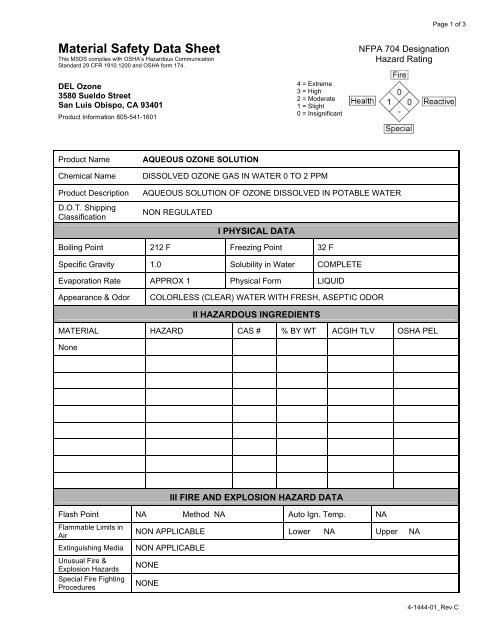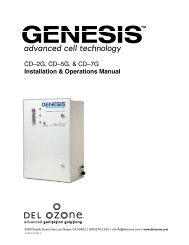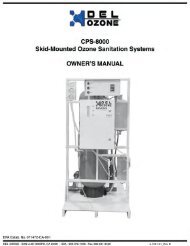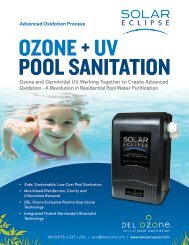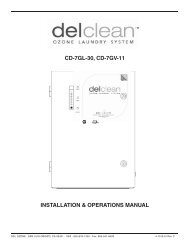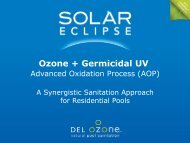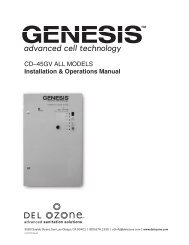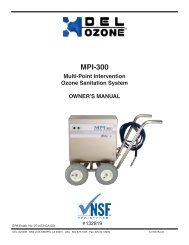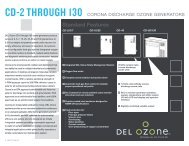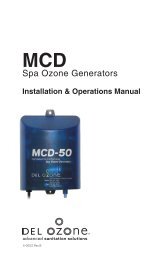MSDS - DEL Ozone
MSDS - DEL Ozone
MSDS - DEL Ozone
Create successful ePaper yourself
Turn your PDF publications into a flip-book with our unique Google optimized e-Paper software.
Page 1 of 3Material Safety Data SheetThis <strong>MSDS</strong> complies with OSHA’s Hazardous CommunicationStandard 29 CFR 1910.1200 and OSHA form 174.NFPA 704 DesignationHazard Rating<strong>DEL</strong> <strong>Ozone</strong>3580 Sueldo StreetSan Luis Obispo, CA 93401Product Information 805-541-16014 = Extreme3 = High2 = Moderate1 = Slight0 = InsignificantProduct NameChemical NameProduct DescriptionD.O.T. ShippingClassificationAQUEOUS OZONE SOLUTIONDISSOLVED OZONE GAS IN WATER 0 TO 2 PPMAQUEOUS SOLUTION OF OZONE DISSOLVED IN POTABLE WATERNON REGULATEDI PHYSICAL DATABoiling Point 212 F Freezing Point 32 FSpecific Gravity 1.0 Solubility in Water COMPLETEEvaporation Rate APPROX 1 Physical Form LIQUIDAppearance & OdorCOLORLESS (CLEAR) WATER WITH FRESH, ASEPTIC ODORII HAZARDOUS INGREDIENTSMATERIAL HAZARD CAS # % BY WT ACGIH TLV OSHA PELNoneIII FIRE AND EXPLOSION HAZARD DATAFlash Point NA Method NA Auto Ign. Temp. NAFlammable Limits inAirExtinguishing MediaUnusual Fire &Explosion HazardsSpecial Fire FightingProceduresNON APPLICABLE Lower NA Upper NANON APPLICABLENONENONE4-1444-01_Rev.C
Page 2 of 3Material Safety Data Sheet Cont.Product NameAQUEOUS OZONE SOLUTIONIV HEALTH HAZARD DATAThreshold Limit ValueNOT DETERMINEDRoute of Exposure Inhalation Ingestion Skin Eye Not HazardousEye Contact HazardIngestion HazardInhalation HazardSkin Contact HazardSkin Absorption HazardEffects of AcuteExposureEffects of ChronicExposureExposure may cause mild eye irritation, but is not expected.Not HazardousInhalation is not likely to be a primary route of exposure but could become irritating ifaerosols are exposed to individual for extended period of time.No skin irritation is expected from short term exposure.No published data indicates this product is absorbed through the skin.Mild skin or eye irritation.Repeated exposure of the skin to concentrated product should be avoided to preventirritation and drying of the skin.V EMERGENCY AND FIRST AID PROCEDURESEye ContactSkin ContactInhalationIf exposure to water containing aqueous solution of ozone causes irritation to eyes, flush eyes withplenty of clean, ozone free, running water for at least 15 minutes, lifting the upper and lower lidsoccasionally. Remove contact lenses if worn. Seek medical attention if irritation persists.Not likely to become irritated unless repeatedly exposed to large volumes of material. If irritationdevelops, rinse affected area with ozone free potable water. If irritation continues seek medicaladvice.Inhalation of mists could lead to irritation of lungs. If symptoms develop, move individual away fromexposure and into fresh air. If symptoms persist, seek medical attention.IngestionNAVI REACTIVITY DATAIncompatibility(Materials to Avoid)Conditionsto AvoidHazardousDecompositionNatural rubber (may degrade, or “dry”, rubber components over extended periods of exposure)NONE KNOWNNONEStability STABLE UNSTABLE Hazardous Polymerization MAY OCCUR WILL NOT OCCUR4-1444-01_Rev.C
Page 3 of 3Material Safety Data Sheet Cont.Product NameAQUEOUS OZONE SOLUTIONVII SPILL OR LEAK PROCEDURESSteps To Be TakenIf Material Is ReleasedOr SpilledWaste DisposalMethodNONEDISPOSE OF THE SAME AS POTABLE RINSE WATERVIII SPECIAL PROTECTIVE INFORMATIONRespiratory Protection(Specify Type)NOT REQUIRED FOR NORMAL USE OF THIS PRODUCTVentilationLocalExhaustMechanical(general)PREFERABLE Special NAOK Other NAProtective GlovesEye ProtectionOther ProtectiveEquipmentNOT REQUIREDNOT REQUIREDNOT REQUIREDIX SPECIAL PRECAUTIONSPrecautionaryLabelingCertified testing of <strong>DEL</strong> <strong>Ozone</strong> systems by NSF (National Sanitation Foundation) has shown thatunder normal conditions of use, aqueous solutions containing low levels of ozone gas dissolved inpotable water do not present a safety hazard when contact to the individual is incidental. Whenused in a room with normal ventilation, levels of ozone gas being released into the air have beenshown by NSF to be well below the periodic exposure levels established by OSHA for workersafety through the use of <strong>DEL</strong>’s ozone management technology.Precautions To BeTaken In HandlingAqueous solutions of ozone in potable water should not be sprayed as an aerosol (i.e. >20psi) toavoid releasing higher levels of ozone gas into the work area. The decay rate of ozone gas is afunction of temperature and exposure to organic material. Certified testing has shown that whenozone gas has been properly dissolved in ambient temperature (or colder (33 – 70 °F)) potablewater at a level not exceeding 2 mg/l (ppm) using <strong>DEL</strong>’s ozone management technology, the rateat which ozone is released from the water as ozone gas is below the PEL established for gaseousozone.Rev. Date 03/26/12This material safety data sheet is provided as an information resource only. It should not be taken as a warranty or representation for which the preparerassumes legal responsibility. While we believe the information contained herein is accurate and compiled from sources believed to be reliable, it is theresponsibility of the user to investigate and verify its validity. The buyer assumes all responsibility of using and handling the product in accordance withapplicable federal, state, and local regulations.4-1444-01_Rev.C


